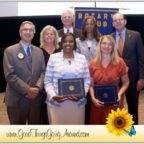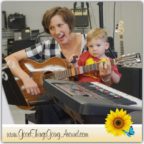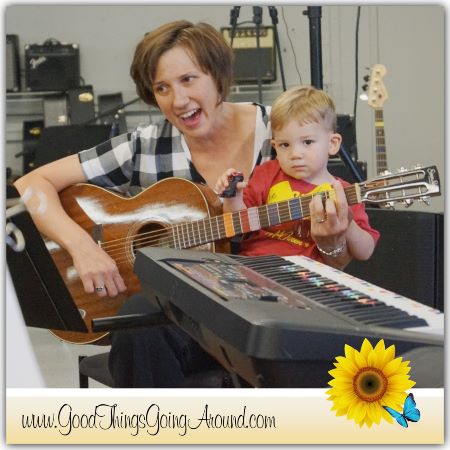featured
Rotary Club Honored CPS Teachers
Teachers who know how to bring out the best in their students are incredible gifts. As they lift minds up, they foster a love for learning, often character values, and sense of worth.
It was great to recently see The Rotary Club of Cincinnati honor Cincinnati Public Schools teachers who developed new programs, expanded education
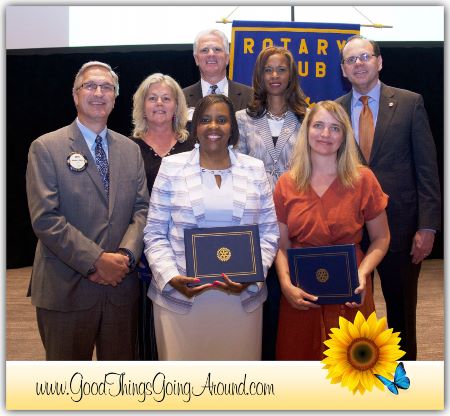
Front row: Rotarian Doug Adams, Honoree Deidre Simpson, Honoree Brynn Thomas. Rear row, from left, Lisa Votaw, Rotarian Mike Vilardo, CPS Superintendent Laura Mitchell and Rotary Club of Cincinnati President Rick Flynn. Honoree Carrie McCarthy was not available for the photo.
beyond the classroom, and inspired students to personal and academic success.
Honorees included:
Deidre Simpson, honored as Innovator of the Year. When Simpson wanted to inject some real-life experience and excitement in her science classes at Evanston Academy, she turned to the Smithsonian’s National Air and Space Museum in Washington, DC.
Supported by GE Aviation, Deidre designed the nation’s first partnership curriculum where professionals from the Air and Space Museum interact with students via real-time internet connections. She also leads the school’s Robotics Team, which has received more than 25 trophies in the past eight years.
Carrie McCarthy, social studies teacher at Woodward High School, received the Teacher Leader award. Carrie is a mentor as well as teacher, focusing on student success both academically and developmentally. “She provides a safe place for students to learn, take chances, and build the skills to succeed beyond high school,” said Laura Mitchell, CPS superintendent.
Brynn Thomas, who teaches social studies at the School for Creative and Performing Arts, received the Community Service/Humanitarian Award. She creates opportunities for her students to engage in meaningful work and implement critical thinking, both in and out of the classroom. Brynn was responsible for bringing the African American Studies course to SCPA and develops projects that have real community impact. One of those projects had students doing research to map historically black businesses in the city.
Lisa Votaw, principal of Aiken High School, was named Administrator of the Year. In a school where 22 percent of the students are homeless or living transient lives, she has built a vibrant support system where students feel safe and can build the skills for a stable future. “She creates a culture where the students want to be at school, they want to learn,” said Mitchell.
The Rotary Club of Cincinnati was founded in 1910 as a service and networking organization with a mission to provide selfless service in the community and the world and to meet needs of children with disabilities. With close to 350 members, it is the largest Rotary Club in Greater Cincinnati. The Rotary Foundation is its philanthropic arm.

Bringing Hope to Parents When Their Lives Collapse
Written by Sue Schindler
It’s the nightmare of every parent to have the police knocking on your door-or-making that call, in the middle of the night. It’s watching your child succumb to a life-threatening illness, when you were confident that they would defeat it. It’s surreal walking in your child’s room and realizing that instead of sleeping, they have no pulse or response. It’s packing up the nursery and closing its door, as your baby is not coming home. It’s now living in a world 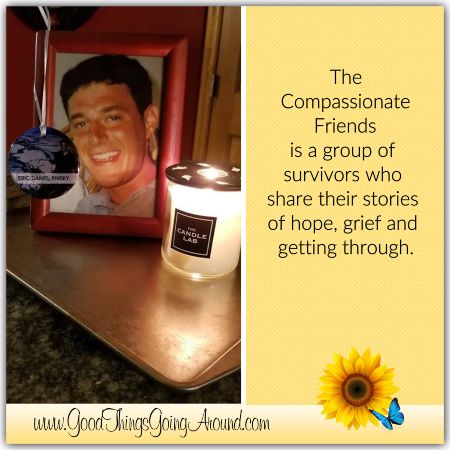 that you never thought would happen to you, because it only happens to “other” parents.
that you never thought would happen to you, because it only happens to “other” parents.
Where does someone go after the loss of your child? The terror of having your child die is one that The Compassionate Friends, or TCF, know all too well. This is a group of survivors who share their stories of hope, grief and getting through. It’s not easy and not for the faint of heart. With love, support, courage and listening to stories, long-time members provide proof that life can be meaningful after the most devastating loss of all- the loss of a young, teen or adult child.
Karen Pinsky is one of three co-leaders at the Tri-County or Springdale’s The Compassionate Friends. Karen says that she “stumbled into the first 14 years” of leadership along with previous newsletter editor title.” Her original intent was to be in this position for 2 years. She and two other parents began the Tri-County chapter 4 years ago, as the need for another chapter presented itself. Members know Karen as the one who has met them at 11:00 PM to talk about their children. She’s also the one whose helped them get away from harmful or toxic relationships. Karen urges parents to take control of holidays, their children’s birthdays and death anniversaries. Get rid of the “shoulds” and do what’s best for you. You didn’t get a vote this would happen to your child.”
Currently, there are three TCF groups in the Cincinnati area: North, East (Lindsay Bibler,leader) West (Michael Urbisci, leader) Along with Karen’s co-leaders, Ed VonBargen and Michael Rapp, warm smiles, words of welcome and a very comforting demeanor to new members and those returning are offered each first Tuesday of the month from 7-9:00 PM at the North Chapter. Michael points out to the group of tonight’s 15 members, that parents from all different backgrounds and ages attend this group. Some spouses come together while others arrive single. Everyone grieves differently. Ed reads a list of TCF expectations. Confidentiality is a must.
TCF meetings offer a safe place where parents, grandparents and siblings can share stories about their loved one. Words can hurt, especially when grief is new and raw. Members find that family or friends can become impatient that they are not over the grief, while others might severe ties out of not knowing what to say. Parents talk about these hurts while also sharing stories about their children. “It’s helpful to know that you will see people in all stages of grieving.” Karen has witnessed many members transition from the anger of loss to rebuilding productive and even joyful lives. Members with more years of child loss, often stay in the group for years to support the newer members. Later in the meeting, a new member comments, “I’ve never had anyone I can talk to, before attending this group.” Others agree.
According to TCF Web site,“The mission of The Compassionate Friends: When a child dies, at any age, the family suffers intense pain and may feel hopeless and isolated. The Compassionate Friends provides highly personal comfort, hope, and support to every family experiencing the death of a son or a daughter, a brother or a sister, or a grandchild, and helps others better assist the grieving family.”
Started over 40 years ago in England, “The Compassionate Friends was established in the United States and incorporated in 1978 in Illinois. Each chapter, along with the supporting National Office, is committed to helping every bereaved parent, sibling, or grandparent who may walk through our doors or contact us.” It is not religion-based.
“Our goal is to have HOPE.” “We share something so profound, that we become a family,” says Karen of this group. “We share what has helped us. We don’t need to tell people what they need to do.” People are not coming for miracles or time- tables for getting over grief.” We “never feel OK” with the loss of our child, but “life does get better.” “No one is expected to talk or share. Members can sit and listen if they want.” As Karen puts it, “You can come back from the depths of Hell.”
Karen’s son, Eric, died in a single car accident 22 years ago at the age of 23. His future was bright as he graduated in only three years from the University of Michigan’s Honors College and was on his way to becoming an attorney. Eric entered Duke University’s Master’s in International Law program on scholarship and arrived before classes started in mid-August 1996. Although receiving another scholarship offer from his dream college, University of Berkeley California after enrolling at Duke, Eric already called Durham, North Carolina his home.
It was 4:00 AM on January 8, 1997, when Karen heard the knock on her door. She had fallen asleep in the family room and was oblivious as to why a police officer was at her home. Although Eric’s accident happened over four- & one-half hours earlier, Durham police were first asked to wait until 9:00 AM before putting through “the call” to local police. Being a parent himself, the Durham police officer knew that Karen and Mike Pinsky needed this information sooner than later and defied orders, finally placing the call at 4am.
Unlike most parents, Karen’s experiences as a Registered Nurse at Cincinnati Children’s Hospital and a private pediatric office, exposed her to seeing other children die. Even so, she was not prepared when it happened to her family. Still in shock, Karen and Mike made travel arrangements to Durham while also planning a Celebration of Eric’s life and notifying family and friends of the unimaginable. Upon arrival, the family grappled with the funeral home staff’s “sales mentality” and postponement of viewing Eric’s body for hours upon hours.
Fortunately, family support and the support of friends helped especially during the early days of Eric’s death. Karen’s brother surprised her by flying in from another city to meet her family at the Durham airport. Duke University administration offered a free stay at the Duke University Inn. Duke’s students and staff wanted to have a memorial for Eric. Karen comments on how speechless she was with the huge impact that Eric’s life had on the other students and staff during such a short time. Eric’s University of Michigan’s roommate, who moved to New Jersey, came for the Celebration along with 400 family and friends. Fred Cook, Karen’s former Cincinnati Children’s Chaplain performed the ceremony.
Returning to Cincinnati, Karen shares that she was an emotional and physical “mess.” Her pediatric office co-workers stepped in for 3-4-months to give Karen time off to grieve. That doesn’t mean that she was “over” Eric’s death. Karen talks about a national survey asking how long it takes to get over the death of a loved one. The average response was 3 weeks. No one recognizes the deep pain and hole in the heart that the death of a child creates, unless they have also experienced.
Karen found online help before attending her first TCF meeting. “I walked in and saw people laughing. I wanted to leave. For the first 3-4 meetings, I sobbed. On the way into a meeting I said to Mike, “If our house burns down, all proof of our child is gone!” She felt enormous comfort when, during the meeting, another father expressed the exact same concern- proving Karen & Mike were in the right place.
What Karen didn’t realize is that people in TCF are in different years of loss. TCF meetings provide families and individuals of what it might look like down the years of loss. One- minute group members might be laughing, at other times, there is a much more serious tone She’s been astounded with the grit and resiliency of families and remembers in detail about attending her first National TCF Conference. Although the keynote speakers lost 5 children, “they were as giving as possible to others.”
Ways to Support Those in Grief
When I asked Karen for suggestions on how people can best support in grief, she said that the biggest misconception is that when it appears that people are moving on with their lives, that’s when the realization of the death is sinking in. You may see them as more talkative or back to their normal selves. In reality, it’s just hitting them that their child is gone.
Karen expresses frustration with the media’s role in death. “They never retract what is written.” They can say that there is “suspected” distracted driving or alcohol or drug use.” However, that’s not always the case. “I know one family where the daughter’s phone was on the floor after her accident. The media said that there was suspected distracted driving. The father checked her phone records and found that she wasn’t using her phone. Don’t assume that what the media reports are the final truth.
Other tips
- Be present
- Listen
- Don’t try to make it better. You can’t.
- Don’t compare. Understandably, it hurt to lose your dog, mom, neighbor, grandfather, but you are not an expert on grief.
- Don’t say to people, “Haven’t you gotten over this yet? Why haven’t you moved on?” If someone is having fun, we don’t ask them to move on. Why is this expected of people in grief?
- Mention the child by name. Don’t make that child the elephant in the room. Sometimes the parent needs permission talk about their child.
- The best thing is to say, “I don’t have any idea what to say, but I’m here for you.”
TCF welcome people at all stages of grief & loss and at all 3 locations. Sometimes people may have experienced a loss years ago, but it’s only now come to the surface. Others might feel stigmatized with the way their child died, while others might be uncomfortable with a child’s diagnosis. There is no judgement for any loss or number of months or years in waiting. With TCF, you will find hope and people who know what you are going through.
Besides monthly meetings, TCF North members meet for a 6:30 PM dinner at a local restaurant on the third Thursday of the month. This month is the Blue Goose in Sharonville, Ohio.
Their Annual Fundraiser is open to the public: 2019 “Painting With A Twist” fundraiser!
PRE-REGISTRATION IS REQUIRED by clicking here!
DATE: Monday, June 17, 2019
TIME: 6:30pm – 8:30pm (Doors open at 6pm)
LOCATION: 6196 Tylersville Rd. / Mason 45040
COST: $40 / person
PICTURE TITLE: Lake Moonrise
Locations, meeting days/times and contacts:
TCF of Cincinnati North 1175
Spring Grove Funeral Home 11285 Princeton Pike Cincinnati Ohio 45246-3701
Email: tcfofcincinnatinorth@gmail.com
Url: http://www.tcfcincinnatinorth.org
Karen: 513- 207-8714 or Ed: 513- 518-9358
7:00 – 8:30 pm 1st Tuesday of each month
Cincinnati Chapter (Westside): 1141 Chapter Number
Mercy Franciscan at West Park 2950 West Park Drive, Cincinnati Ohio 45238
Email: tcfcincywest@yahoo.com
Url: http://www.tcfcincinnatiwest.org
Michael: 513-205-8291
7:00 PM on the 2nd Wednesday of each month
Greater Cincinnati TCF – East Chapter 1969
8101 Beechmont Avenue, Cincinnati Ohio 45255-3190
Email: tcfcincyeast@gmail.com
Url: http://www.tcfcincy.com
Lindsay: 513- 652-7470
7:00 pm on the 4th Tuesday of each month (except December)

Finding Similarities Through Melodic Connections
Written by Sue Schindler
It was the third Tuesday of the month as I walked into the Melodic Connections studio at 6940 Plainfield Road in Silverton for their 5:30-7:00 PM Common Time community event. Common Time is the brainchild of Executive Director Betsey Zenk Nuseibh, to bring communities together through music.
Recently inducted into the University of Cincinnati’s College Conservatory of Music (CCM) as 2019 Distinguished Alumni of the year, Betsy is first and foremost a “disrupter” in music and community relations. It showed throughout the evening. Common Time is the culmination of years of “seeing what works” and taking the leap of faith. No one does this better than Betsey. She has the instincts to bring out the best in others as their spirits and confidence shines through.
Having high enthusiasm and anticipation, I wrote down my required purpose for the evening, “Blog Writer.” Purposes are shared at the beginning of the session to begin the overall connections and clearer understanding of each other. Per their website: “When we express ourselves with intentionality, we know we will arrive at a place that is better than before.”
Lynn Migliara, Melodic Connections development director welcomed me, as I entered the huge music studio that easily seats 60 musicians. I was one of the first to sit in a circle that was in the shape of a snail’s shell. It was filled with chairs; music stands and a variety of instruments. Lynn explained that this set-up ensures that everyone is included.
At these events, each member is a “musician.” Instrument selections range from guitars, keyboards, and a variety of percussion instruments. Percussion includes tambourines, hand bells, and egg-shaped shakers to snare & bass drums, to the more exotic: bongos, cabasas, conga drums and drums that mimic the sounds of the rainforests. Musicians are welcome to keep or change instruments as they desire. Those with vocal chops are encouraged to use microphones for singing. The night I attended (just as at each event) we played and sang at our level of expertise.
Lynn eagerly shared that Common Time welcomed Cincinnati Symphonic Orchestra members to one of their first events. Melodic Connections also offers weekly Common Time to Roll Hill Elementary in Fairmount, to increase relationships between its students and their parents as they learn to play guitar, keyboards and drum.
Through 15+ years of professional and personal contact with Betsey, I knew that night would be special. Betsey offered a warm welcome and shouted out 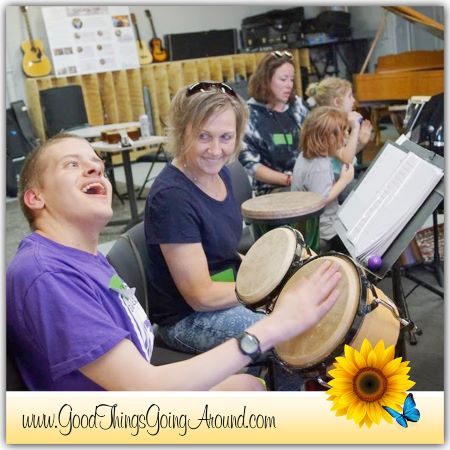 our purposes for attending. Most wanted to make music and jam. Betsey introduced Common Time’s local musician of the evening, Jim Pelz, who sat in the center of the circle. Jim is a country-rock songwriter and performer who, when he’s not playing solo or with his band, Hickory Robot, sits in other local bands.
our purposes for attending. Most wanted to make music and jam. Betsey introduced Common Time’s local musician of the evening, Jim Pelz, who sat in the center of the circle. Jim is a country-rock songwriter and performer who, when he’s not playing solo or with his band, Hickory Robot, sits in other local bands.
Lynn explained that each Common Time Musician of the Month goes through specialized training with Melodic Connections certified music therapists. As the purpose of the evening is community bonding first and foremost, music is fun but not perfect. Per website, “Music is the journey and not a destination.”
As Jim called out our first song, we grabbed our instruments, and were off to a robust start. The positive energy increased throughout the evening especially as more musicians, from young children to older adults, join the circle. Keeping up with finding the songs in the music book was challenging to me, as we covered a wealth of music of different styles and eras. Music ranged from the Beatles’, “Hey Jude,” to the Grateful Dead’s, “Ripple,” to Johnny Cash’s, “Folsom Prison Blues.”
Halfway through, we broke into circles of three. Betsey encouraged us to meet someone new during this time. We talked about what the event’s experience meant to us. My group was the exception of four as a young woman said that she was interested in meeting the musician sitting next to me. She liked his sporty red wheelchair and wanted to know more about him. He smiled and the two continued to talk. Everyone was having so much fun getting to know one another that there was hesitation with going back into the big group. Amy staid next to her new friend as we sang, “Don’t Worry, Be Happy.”
The History
Melodic Connections, a 501(c3) has provided community musical experiences for more than 2000 individuals in special education classrooms, adult programs, after school classes, summer camps and through off-site partnerships. As a former high school music teacher and music therapist, Betsey started Melodic Connections in 2008 after recognizing that students with disabilities can learn best when provided with alternative supports and teaching methods. Not only does Betsey and her staff of 12 certified music therapists provide community opportunities for her musicians, but she is now connecting the community to the Melodic Connections family through Common Time.
My history with Betsey goes back into early 2000, when she was a Cincinnati Public high school music teacher. As a case worker, we shared a special needs student who has Autism, whose parents tried to home school. Attending this middle & high school was his introduction into public education and a culture shock from being in his small home. This teen was frightened and struggled with focus and learning until Betsey came into the picture. Staff marveled with how easily this music teacher included the teen with the other high school students through playing percussion. Betsey’s skills and attention provided him with first step in focusing and gaining the social and educational skills that he desperately needed.
Throughout our daily lives, we are so involved with our own reactions or insecurities in knowing how to reach out to others that we don’t take the time or effort to know one another. Common Time reinforces that cultural, language, abilities, lifestyles, and/or personal experiences are to be celebrated. On that night, I saw and felt us as “one” group without labels or differences. We were alike in sharing common ground in music and our communications. As time ended, Betsey asked for evening observations. The group comments were, “Joy,” “Happiness,” “Friends,” and “Fun”. As I walked away still talking to others, I knew that I am a better person for this experience. I will return.
Everyone is welcome to join Melodic Connections studio on Tuesday, June 18, 2019 for the next Common Time with local musician, Dan Van Vechten, 9440 Plainfield Road, Cincinnati 45236.
Please visit Melodic Connection’s website for additional information on Common Time, classes and summer opportunities.

Life Lessons From A Triangle
Children have such huge potential for learning, and when they are taught from the earliest of ages to accept and appreciate each other’s differences – even to look beyond those differences to see what they have in common – it is one of life’s greatest lessons.
I get so touched by seeing and even being a part of those opportunities. It is a beautiful sight to see young children who look and do things differently, laugh, play, learn, and participate together. When this happens, all of them grow as a result.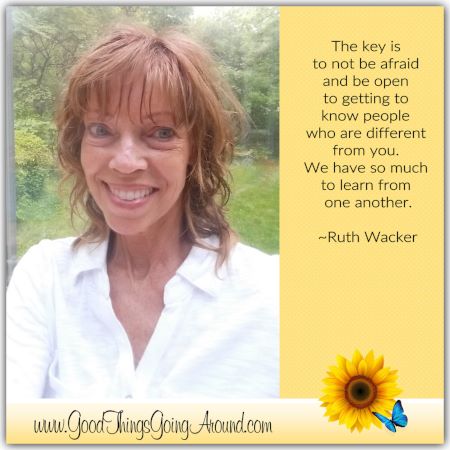
This is why, as soon as my dear friend Blythe Pietila showed me the picture book, Timmy Triangle in Square Park written by Blythe’s friend, Ruth Wacker, I loved it right away…and wanted a copy to read to kids.
With simple words, cheerful illustrations and an easy-to-follow story line, the book teaches this lesson so that young minds are engaged and can understand. It focuses on Timmy Triangle, who tapes another triangle to himself just so that he looks like all the squares and can play with them in their park. They were having so much fun together…until, Timmy’s second triangle fell off during jump roping and was told he could no longer play there. That is when Sammy Square picked up the fallen triangle and announced his discovery, “Look, everybody…I’m made of two triangles!” And they realized they were really all alike. From that day forward, the squares welcomed the triangles in the park.
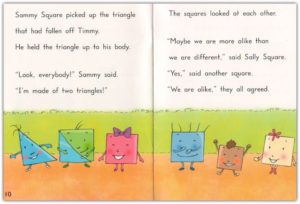
Timmy Triangle in Square Park is now among my favorite picture books for early readers (published by Reading Reading Books).
I had to talk with Ruth to learn more about the woman behind the story; and when I did, I came to see how this was such a natural project for her. Her friends know her as probably one of the nicest people they know because she loves to smile and make others smile. Someone told her recently, “When I walk away from you, I always feel better.” I can absolutely see that. I seemed to be smiling more when I hung up the phone from our conversation.
Ruth told me that may come from her roots (and the many self help book she regularly reads), growing up in a farming town of what she guesses may include some 300 people. She has three sisters and a brother, and parents who were farmers. From her family she learned about motivation, faith, hard work, love, and lend a hand to neighbors.
And she no doubt instilled those same values into her two adult sons, her biggest inspiration. “They are such selfless people, always willing to help other people. They’ve inspired me with their lack of worry. They have this thing about them that no matter what happens, everything will be ok and it will be good,” she told me.
A first grade teacher many years ago, her children’s writing (she has written several other stories for Amazon Rapids, an app for 8-12 year olds by Amazon Education) is a mix of her passion for writing, teaching, and encouraging friendship and discovery in young people.
Ruth’s voice cracked as she began telling me of Ryan, the inspiration behind Timmy the Triangle in Square Park.
The son of one of Ruth’s friends who is now in his 20’s, Ryan loves golf and would be the first person to pick up something you dropped as an act of kindness. He is also very big into following the rules and is often in a good mood. When his older brother was on the St. Xavier High School football team, Ryan was the team helper. The players looked at him as one of their own.
Yet there were also many kids who kept there distance from Ryan. His having down syndrome meant he looked and did things different from his peers as a child and that made some of them uncomfortable. They didn’t know how to be or act around him. “They were afraid of hanging out with him because they didn’t know what he was capable of, and he has a lot to offer,” Ruth told me.
“You have so much to learn from people who you may be afraid to get to know but if you just say, ‘it’s ok to get to know them’, you will be a better person and they will be better people. It goes for everyone. People should be judged by their character instead of what they look like. I am a big believer in that, and also I believe that kids should grow up to be curious about things. It is how they learn,” she said.
Below are a few more questions I asked of Ruth.
Lisa: What makes you smile?
Ruth: A lot makes me smile. The first thing I think about when I wake up is what I am thankful for. You can always make a list. Mine includes family, friends, my health, sunshine, a job, a house, food, music, books, my dog. The list could go on and on.
Lisa: What advice would you give a younger version of yourself about leading your best life?
Ruth: I used to always be in a rush about everything. I would see how much I could accomplish in an hour. My best advice would be to slow down. Now I love meditation because it makes you aware of so much more instead of having the blinders on with only one path. Open those blinders up. You never know what you may miss laying on the side of the road. Be open to changing your path. I also believe in signs. You’ve got to be open to the fact that something someone says may trigger a thought that means, ‘wait a minute, I’ve been going down the wrong way.’

Life Taught Charlie About Tenacity
Written by Sue Schindler
If you live in the Greater Cincinnati area, you’ve probably heard or seen the UC Health commercials with that booming, yet reassuring voice,
“They call us the tenacious. The authors of breakthroughs. The ambassadors of hope.”
 That voice belongs to Lebanon, Ohio’s Charlie Hines. A talented and versatile musician and songwriter, Charlie gives his all when writing and arranging music, singing and playing guitar and keyboard, encouragingly mentoring musicians of all ages and abilities, and recording voice overs for national Walmart and other companies, colleges, churches and commercials. Charlie even wrote the national campaign song for Luxottica’s, Gift Of Sight, (now One Sight) nonprofit program during his time in the corporate world.
That voice belongs to Lebanon, Ohio’s Charlie Hines. A talented and versatile musician and songwriter, Charlie gives his all when writing and arranging music, singing and playing guitar and keyboard, encouragingly mentoring musicians of all ages and abilities, and recording voice overs for national Walmart and other companies, colleges, churches and commercials. Charlie even wrote the national campaign song for Luxottica’s, Gift Of Sight, (now One Sight) nonprofit program during his time in the corporate world.
Referring to Dictionary.com for, “tenacious,” this word effectively describes Charlie: persistent, determined and steadfast. He recognizes gratitude while overcoming obstacles. He continually embraces the people in his life especially valuing his lifelong friendships. Charlie is quick to point out words of inspiration, as we talk in his state-of-the-art home studio.
He is a passionate family man, husband and father and lover of life. He treasures his new and lifelong friendships and enthusiastically comments on how he now musically advises the teen and adult children of these friends. “There is no expiration on the seeds we sow,” he told me. As a compassionate and continuous giver, Charlie advises to be on the lookout for what you can do to encourage others. “Your mission could be the people in your back yard,” he said.
Charlie fondly talks about giving a first guitar lesson to the child of friend, recording artist Tim Miner, in Colorado. Charlie held this child just a few hours after birth while wearing “that cone head blue cap.” This is the child who called Charlie, “Rah, Rah,” and now has a worship ministry of his own.
Charlie strongly idolized Tim’s teenage voice during his teens, as Tim was already an established recording artist. Through a social media re-connection, Tim agreed to provide vocal and musical backgrounds on, “A Charlie Hines Christmas” 2018 album.
Joe Boyd, CEO of Cincinnati-based Rebel Pilgrim Productions, and Charlie met while Joe was the teaching pastor and Charlie was the worship leader at Vineyard Cincinnati. Joe referred Charlie to his recent UC Health voice over, which after auditioning, Charlie performed from his home studio.
Prior to a budding music career, as a guitarist, Charlie was an avid soccer player. At age 14, a deteriorating hip left him sidelined and hospitalized for 8 weeks. While recovering in the hospital, he was introduced to the guitar. “I was frustrated with the healing process of my hip. However, there was another purpose for me. If I hadn’t been in the hospital, I never would have learned how to play the guitar or be the musician who I am today.”
A Columbus, Ohio resident born in Virginia, his father’s military career led the family to Stuttgart, Germany soon after his hospital discharge. Arriving on crutches as his hip continued to heal, Charlie’s new guitar expertise quickly gained him acceptance into a new church band as he continued making lasting friendships. Prior to Stuttgart, Charlie only played in his Catholic Church’s folk group. In Stuttgart, he met Clarence Church and Tony Sutherland. Today they are accomplished worship pastors, writers and authors.
And what happened to Charlie’s soccer career? Once his hip was healed, Charlie played for Stuttgart’s Military-based school soccer team, the Patch Panthers. They played other military-based schools with the much more athletic German players. It was with the Patch Panthers and during Charlie’s first game back from his hip recovery that he scored his first and only career goal. Not only did Charlie hear God telling him, “I allowed you to find music at the expense of soccer. But I didn’t want to take soccer away from you.”
Charlie vividly remembers the team’s 1984 train ride into East Berlin. It was five years before the Berlin Wall was taken down and East Berlin was communist controlled.
On the right side of the track was West Berlin with blue skies, the German Polezi wearing green, and American Military Police. “It was safe.” The city was lit up and like any city of the free world.
When looking to the left, or East Berlin Polezi were dressed in blue and the soviet border guards were dressed in their Russian red., Charlie saw bombed-out buildings and no people roaming the streets. West Germany was home to the Porsche, BMW and Mercedes, but the only cars roaming the streets in East Berlin were white Trabants. (Writer’s note: History calls, them “the worst car ever made.”)
Disobeying their coach’s instructions of not pulling down the train’s windows to talk with East Berlin soldiers out of concern of being shot, Charlie and his friends tried to engage anyway. “The soldiers ignored the soccer players”, as Charlie recalls their “stone-faced” expressions.
While playing that soccer game, Charlie noticed several holes in walls and anchors in the platforms around the stadium and was told these were effects of bomb blasts, and where tanks were anchored in on display. Charlie internalized that just 40 + years before playing here, he could have been shot to death for being African American or being an American!
After moving to Cincinnati, years later, one of the first things he did was to drive to Voice of America (VOA in Butler County Ohio). Charlie got out of car to recognize how VOA’s broadcasts into East and West Germany played a huge role in our freedom. Charlie points out that Hitler frequently referred to the VOA as the Cincinnati Liars because their broadcasts dispelled enemy propaganda.
I could have listened to Charlie’s words of wisdom and vast experiences for much longer than our time allowed. His final words of wisdom involved moving from worship director at a larger church to one that is more intimate. Charlie explained that the initial move was difficult. It was the only church that his daughters ever knew. “It was the source of my income, spiritual growth, the place where I could exercise God given gifts, lead a team of people and was the foundation of so many life- long friends. Anyone would feel lost if it all ended suddenly,” he said.
Now three years removed, settled and very comfortable in this newer setting, his advice is to, “Let go of the ego & do what you do best. It doesn’t matter the size of your audience.” Charlie Hines is persistent, determined and steadfast. We call him, “tenacious.”

